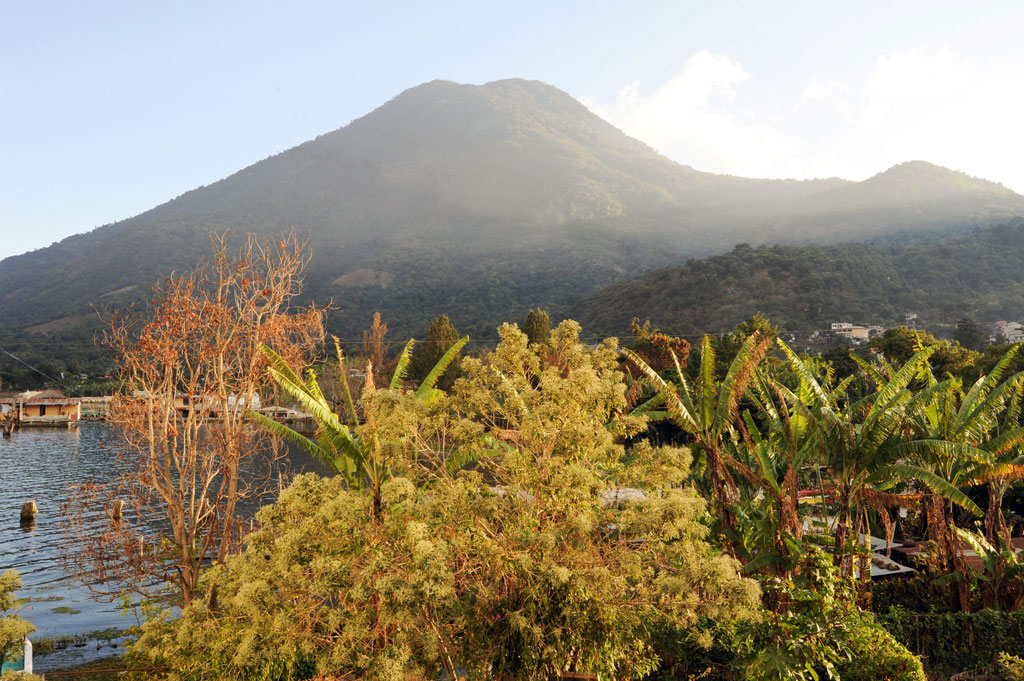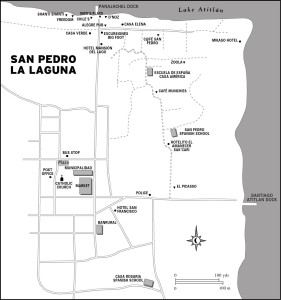
San Pedro Volcano and the town of San Pedro La Laguna. Photo © Stefan Ember/123rf.

San Pedro La Laguna
On the lake’s southwest corner and accessible by frequent boats or road, San Pedro is second in popularity only to Panajachel and has a hip international atmosphere. The place has grown by leaps and bounds, from a once-scruffy village to a rather pleasant lakeside town with a solid international presence. You’ll see signs in English, Spanish, French, and even Hebrew as you walk along the paths winding through town. The atmosphere in San Pedro embraces a simpler state of being and you’ll have no trouble slowing down to the local pace of life amidst the serene tropical foliage.The town flanks the northern slopes of San Pedro Volcano, a popular climb for which the town is ideally suited as a base. It has increasingly become home to a number of language schools, some of dubious quality, collectively offering some of Guatemala’s least expensive tuition rates. While it was originally a backpacker Shangri-La, there have been recent additions to the hotel infrastructure, making for suitable accommodations to house the non-backpacker crowd.
The bulk of the tourist hotels and services are between two docks, on the southeast and northwest sides of town, and in the areas adjacent to them. The first one serves boats to/from Panajachel and the rest of the lake towns; the other is for boats to Santiago Atitlán. They are about one kilometer apart. The area between them is known as El Otro Lado (The Other Side). Street numbers and names are not generally in use here. From the Santiago dock, go up about 50 meters and turn right on the footpath known as 7th Avenue to get to El Otro Lado and continue to the Panajachel boat dock. From the latter dock, go up one block and turn left to get to the other side of town. Numerous hand-painted signs will direct you almost anywhere you want to go.
In recent years there’s been some tension in San Pedro due to the proliferation of evangelical churches and their congregants who sometimes look upon San Pedro’s foreign presence as an unwelcome, “sinful” hindrance. On at least one occasion, congregants have surrounded a well-known bar and forced it to shut down for the night. The palapa lounge at the Israeli-owned Zoola restaurant and hotel has been burned down twice, leading some to wonder if the attacks were perpetrated in the name of anti-Semitism. The lounge has since been replaced with a less flammable canvas substitute.
The volcano became a national park in 2006, so it is hoped that, as was the case with Pacaya Volcano, its newly protected status will result in greater police presence and an end to the robberies that frequently happen near the summit. For now, check with locals before heading up the volcano. Under no circumstances should you attempt this hike alone. Always go with a local guide. There is a visitors center at the trailhead, which is just off the road to Santiago. The hike is fairly strenuous, as the trail runs straight up the mountain with very little in the way of switchbacks. It takes about 4-5 hours to reach the summit, which is still very much covered in thick cloud forest. There’s a small gap in the trees at the top from which there are views of Santiago and the lake. Start your hike early in the day to avoid the midday heat and the clouds that typically gather at the summit of the lake’s volcanoes in the afternoon.
Activities include horseback riding and hikes up a mountain known locally as “Indian Nose,” as its shape resembles the profile of a Mayan nose like those depicted on stelae. Horseback riding is available from Rancho Moiseís (next to Zoola hotel, tel. 5967-3235). Next door to Chile’s restaurant on 8a Calle, Restaurante Elena rents kayaks for $2 an hour.
Walking to other villages from here makes sense from a logistical perspective, though too frequent reports of robberies along the trails prevent me from recommending this as a viable activity. If you do decide to go on any of the hikes, bring only that which you wouldn’t mind losing.
You can swim from either of the docks (watch out for boat traffic) or anywhere along the lakeshore, though recent pollution concerns have made a dip in the lake much less appealing. Your best bet to beat the heat is La Piscina de San Pedro (on the street heading up from the Santiago boat dock, about 50 meters, tel. 4708-3905, 11 a.m.-dusk daily), where it costs $2.50 to swim (children $1.25) in a pleasant, clean swimming pool surrounded by tropical plants and mural art. A lively bar keeps things hopping. There’s a weekly bocce ball tournament and southern-style barbecue on Saturdays starting at 1 p.m. and costing about $8.
If you like your water bathtub-warm, you have at least two options for soaking in hot tubs. Both places feature concrete tubs filled with water that is solar-heated in black plastic tubing and pumped into reservoirs of various sizes. (You’ll need to call ahead or visit with at least one hour’s prior notice so they can draw the bath.) It costs $7 for one person, but you can split the cost with others sharing the same pool. The first of these, Solar Pools (7a Avenida 2-22, Zona 2, tel. 5770-5119, [email protected], 8 a.m.-11 p.m. daily), is located on the main strip of El Otro Lado. Of the two, Solar Pools holds the slight edge in landscaping and it has an adjacent snack bar, Tzan Saqarib’al, serving light fare. You can reserve by phone. Closer to the lakeshore and a short walk down a side path is Los Termales (8:30 a.m.-11:45 p.m. daily), the town’s self-proclaimed original hot tub operation. Its biggest draw is the sylvan lakeside setting. They prefer that you pre-book your tub in person.
Excursiones Big Foot (tel. 7721-8202), on the main drag as you come up the hill from the Panajachel dock and turn left, is San Pedro’s most reliable outfitter and has been in operation since 1995. It offers trips to San Pedro Volcano with knowledgeable guides and security for $14, including park admission. Big Foot can also guide you to Indian Nose with a four-person minimum for $5 p/p. Casa Verde Tours (tel. 5837-9092 and 7721-8344) just down the street from the Panajachel boat dock, is the town’s other recommended outfitter. They also have a variety of daily shuttle departures.
San Pedro is a lively town harboring several bars where the party goes on until about 1 a.m. A great place for happy hour is Chile’s (tel. 4222-8292), with a large wooden deck overlooking the lake. Happy hour runs 6-8 p.m. and includes 2-for-1 drink specials.
Just to the left of the dock and directly above Nick’s Place, D’Noz is a lively bar with good food, including baguettes and croissants, where movies are shown nightly at 8:30 p.m. In the center of town between the two docks, the ever-popular Buddha Bar, housed in a three-level building with a cool Asian atmosphere, has pool tables and dartboards on the first floor. For live music, check out En Vivo (up the street from the Panajachel dock and left). Closer to the Santiago dock, your best bet is La Playa, a British-owned sports bar with indoor and outdoor seating along with four big screen TVs. The town’s neighborhood bar is El Barrio (7th Ave., 5 p.m.-1 a.m. daily) in the heart of the tourist zone. Happy hour is 5-8 p.m. and includes 2-for-1 drinks. They also have tasty burgers.
There’s a Banrural (with ATM) in the heart of town, reached by heading straight up the street from the Panajachel dock for about a kilometer. You’ll pass the town market on your right, two blocks before the bank, which will be on your left. From the Santiago dock, head up the street and turn left at the market. There’s also an ATM machine just off the Panajachel dock.
For Internet and phone calls, D’Noz is just off the Panajachel dock, or you can head up the street one block to Casa Verde Tours (tel. 5837-9092 and 7721- 8344), your all-in-one stop for Internet, laundry, international calls, and full-service travel agency including shuttle buses to Antigua, Guatemala City, and Xela. On the main drag, turning left at Casa Verde as you come up from the Panajachel dock, you’ll find Café Jardín (7:30 a.m.-9 p.m.), serving breakfast and snacks in addition to offering Internet access. Both charge about $1 for an hour online.
Recommended language schools include the following: Casa Rosario (Canton Sanjay, tel. 7613-6401) and Corazón Maya (first left up the street from Santiago dock, tel. 7721-8160). Also along this street is Sol de Oro Spanish School (tel. 7614-9618). In the El Otro Lado sector between the two docks are Escuela de Español Casa America (tel. 7767- 7718, [email protected]), Mayab’ Spanish School (tel. 7815-7722), and San Pedro Spanish School (tel. 7721-8176).
There are boats every half hour to Santiago (30 minutes, $2) from the dock at the northwest part of town. Lanchas also leave throughout the day for the lakeshore villages of San Marcos ($1.50), Jaibalito ($2), Santa Cruz ($2.50), and Panajachel ($3). All leave from the dock on the southeast side of town. The last boat going in either direction usually leaves around 5 p.m.
There are buses to Quetzaltenango ($3, 2.5 hours) leaving from in front of the church in the main part of town at 4:30, 5, 5:30, 6, 7, 8, 10:30, and 11 a.m. Monday through Saturday. On Sundays these buses leave at 5, 5:30, 6, 8, and 11 a.m. There are buses to Guatemala City from San Pedro departing Monday through Saturday at 3:30, 4, 5, 5:30, 6, 8, and 10 a.m. Afternoon buses depart at noon and 2 p.m. on the same days. Sunday departures for Guatemala City are at 6 and 7 a.m. and noon, 1, and 2 p.m. There are frequent pickups to the villages as far as the road goes to San Marcos and in the other direction to Santiago. Shuttle vans ($25) leave from San Pedro (Casa Verde) at 9 a.m. daily for Antigua and Xela.
Excerpted from the Fourth Edition of Moon Guatemala.